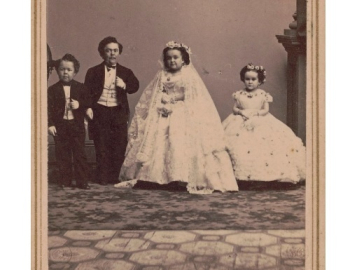4 October 1861
The first, global, celebrity entertainer was the dwarf General Tom Thumb, a.k.a. Charles Stratton. Born in 1838 in Bridgeport Connecticut, Stratton was discovered at age four by Phineas Taylor (P.T.) Barnum, the future circus impresario and then owner of Barnum’s American Museum. At only twenty-five inches tall, the child, who reportedly had weighed a hefty 9 ½ pounds at birth, had not grown since he was six months old. Barnum, always on the look-out for the odd and the unusual for display in his museum, which was a mixture of a menagerie, theatre, lecture hall, and sideshow, had stumbled upon a winner. The child was quickly signed to a contract and taught to dance and sing. Little Charles put on his first performance at the American Museum at the age of five though billed as an eleven-year old. His stage name was General Tom Thumb after the fairy tale character of the same name. Precocious and talented, Stratton was an instant hit. Barnum made a fortune as New Yorkers flooded into his museum to see General Tom Thumb.
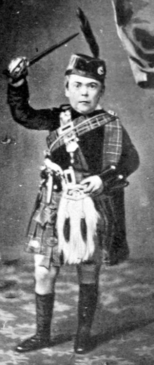 “General Tom Thumb” dressed as a Scottish clan chieftain, c. 1861, author unknown, Wikipedia.After wowing New York audiences, Barnum took him and his parents to London, the centre of the world in the nineteenth century. His London debut occurred in February 1844 at the Princess Theatre in London. Following a performance of the comic opera Don Pasquale, Stratton came on the stage singing Yankee Doodle Dandy. He later entertained the audience dressed as Napoleon and performed in a number of “tableaux” as Hercules, Ajax and Sampson. But the act loved best by the crowd was his performance as Cupid, complete with little wings.
“General Tom Thumb” dressed as a Scottish clan chieftain, c. 1861, author unknown, Wikipedia.After wowing New York audiences, Barnum took him and his parents to London, the centre of the world in the nineteenth century. His London debut occurred in February 1844 at the Princess Theatre in London. Following a performance of the comic opera Don Pasquale, Stratton came on the stage singing Yankee Doodle Dandy. He later entertained the audience dressed as Napoleon and performed in a number of “tableaux” as Hercules, Ajax and Sampson. But the act loved best by the crowd was his performance as Cupid, complete with little wings.
His reception was not quite up to the adulation received earlier in New York. But that was soon rectified following multiple audiences with Queen Victoria, Prince Albert and their family, including the three-year old Prince of Wales. It seems Stratton became a hit after he pretended to fend off one of the Queen’s barking spaniels with his miniature sword. Performances throughout Britain were followed by a tour of continental Europe.
General Tom Thumb first ventured northward to Canada in 1861. It was a good time to perform outside of the United States; the U.S. Civil War had begun in April of that year. At the beginning of October, the troupe came to Ottawa, staying at Campbell’s Hotel, which would be purchased by M. Gouin two years later and renamed the Russell House Hotel.
General Tom Thumb was in town for a two-day gig at Her Majesty’s Theatre located on Wellington Street just west of Bank Street. There were two performances on each of the 4th and 5th of October 1861. Ticket prices ranged from 10 cents for children under ten to 25 cents. Reserved seats were 25 cents each. School groups were admitted “on liberal terms.” Along side General Tom Thumb were the English comic actor and baritone, Mr. W. Tomlin, the American tenor, Mr. W. DeVere, and the pianist Mr. P.S. Caswell. On display at the theatre were the gifts Stratton had received from royalty during his European tours. Interestingly, the advertisement in the Ottawa Daily Citizen warned people to beware of a General Tom Thumb impersonator who worked for Robinson & Company’s circus.
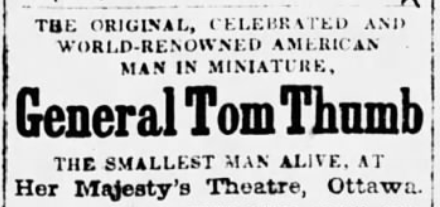 Advertisement that appeared in the Ottawa Daily Citizen, 1 October 1861.The spectacle began before the actual theatre performance, with General Tom Thumb driven from Campbell’s Hotel to HM Theatre in a miniature carriage drawn by “Lilliputian” horses. He was also “attended by Elfin coachmen and footmen.” The reporter who covered the event for the Ottawa Daily Citizen described Thumb as multo in parvo—a great deal in a small space. He opined that Stratton had “fully carried out the universal reputation he has acquired.” He praised the performers acting, singing and dancing abilities, and specifically singled out Stratton’s self-possession as an actor and a readiness of wit. He also had “perfect manners and form.”
Advertisement that appeared in the Ottawa Daily Citizen, 1 October 1861.The spectacle began before the actual theatre performance, with General Tom Thumb driven from Campbell’s Hotel to HM Theatre in a miniature carriage drawn by “Lilliputian” horses. He was also “attended by Elfin coachmen and footmen.” The reporter who covered the event for the Ottawa Daily Citizen described Thumb as multo in parvo—a great deal in a small space. He opined that Stratton had “fully carried out the universal reputation he has acquired.” He praised the performers acting, singing and dancing abilities, and specifically singled out Stratton’s self-possession as an actor and a readiness of wit. He also had “perfect manners and form.”
There still appeared, however, to be some doubt in the reporter’s mind of whether he had watched a performance of the genuine General Tom Thumb. He added that “there was every reason to believe that this one is the ‘original’ Tom Thumb, but whether or not, both he and his ‘aides’ perform a perfect array of rational and attractive entertainment.”
General Tom Thumb returned to Ottawa three more times, in 1864, 1876 and lastly in 1883. On all three occasions he was accompanied by his wife Lavinia who he had married in 1863. The 1864 performance included members of their wedding party—Commodore Nutt, also referred to as the $30,000 Nutt in reference to the value of his three-year contract with P.T. Barnum, and Lavinia’s sister, Minnie Warren. The notice for their show advertised that the “four smallest human beings of mature age” weighed a collective 100 pounds. For part of their 1864 performance, General and Mrs. Thumb wore their wedding costumes. The couple danced and sang. General Thumb also dressed up as Napoleon and a Scottish clan chieftain. Commodore Nutt appeared as a drummer and a sailor with a hornpipe. As with Thumb’s 1861 shows, on exhibit at the HM Theatre were the jewels and other gifts that he had received on his European tours.
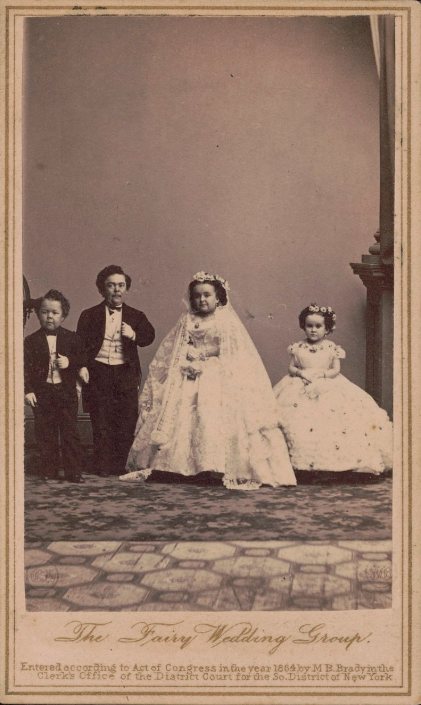 The Fairy Wedding, Souvenir Photograph, 1863, Commodore Nutt, General Tom Thumb, Mrs. Tom Thumb, and Minnie Warren (left to right). By this point, the General has already grown a bit. Author Mathew Brady, Wikipedia.
The Fairy Wedding, Souvenir Photograph, 1863, Commodore Nutt, General Tom Thumb, Mrs. Tom Thumb, and Minnie Warren (left to right). By this point, the General has already grown a bit. Author Mathew Brady, Wikipedia.
In 1876, General and Mrs. Tom Thumb performed over two days at Gowan’s Opera House. Their act was much the same as that of their previous trip to Ottawa, but this time they were supported by Major Edward Newell, another dwarf under contract with Barnum. Newell was the husband of Minnie Warren, Mrs. Tom Thumb’s sister. Minnie was sadly to die in childbirth two years later.
General and Mrs. Tom Thumb’s 1883 Ottawa performances took place in May of that year, with shows at the Grand Opera House. By this point, the General had actually grown to a still tiny 2 feet 11 inches. He had also grown stouter. The Ottawa Daily Citizen commented that both he and Lavinia were “getting on in years.” Still, the General’s act was described as very amusing. Mrs. Stratton was described as “as charming as ever.” Along with the General and his wife, other members of their troupe included dancers, a ventriloquist and a lady whose odd act consisted of “highly educated, trained canaries.” What these canaries did was unfortunately not reported.
This was to be the general’s last trip to Canada’s capital, and indeed virtually anywhere. He died two months later of apoplexy (most likely, a stroke) at his country home in Middleborough, Massachusetts. He died a prosperous man, leaving his wife a substantial home and a motor yacht. His estate after expenses was valued at $16,000.
His widow, Lavinia, continued in show business. In 1885, she married “Count” Primo Magri, another dwarf who was actually shorter than General Tom Thumb. The newly-weds went on tour together, along with Magri’s supposed brother, “Baron” Magri. Like all things in show business, especially anything connected to P.T. Barnum, truth and fiction were blurred. The titles of nobility were likely fake.
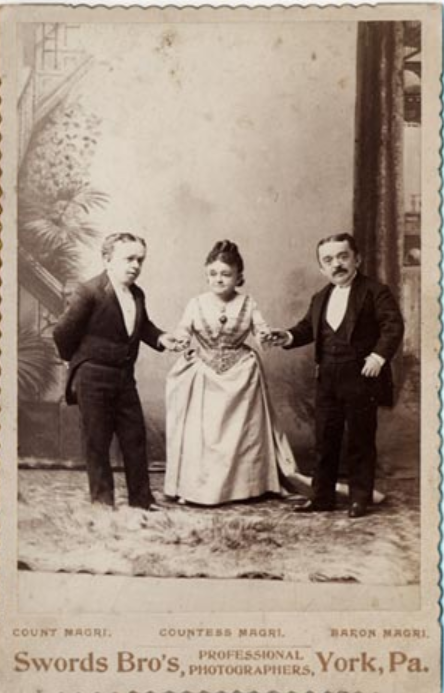 Count Magri, Countess Magri, and Baron Magri, c. 1885, Swords Brothers, Wikipedia.The Count and Countess Magri made two trips to Ottawa, the first in 1887 and the second in 1896. Both were successes. In the first production, the Count and Countess arrived at the theatre in a tiny carriage pulled by two ponies. The pair sang duets, while the Count and his brother Baron Magri duelled and entertained the audiences with comic sketches. They were accompanied by a magician who put on conjuring and ventriloquist act. Much the same act was repeated in 1896. This time, however, Lavinia, Countess Magri, also gave a lecture on her forty years of travelling. The Citizen journalist reported that the lecture was very interesting and pleasing, and that the Countess had “a wonderful talent as a speaker.”
Count Magri, Countess Magri, and Baron Magri, c. 1885, Swords Brothers, Wikipedia.The Count and Countess Magri made two trips to Ottawa, the first in 1887 and the second in 1896. Both were successes. In the first production, the Count and Countess arrived at the theatre in a tiny carriage pulled by two ponies. The pair sang duets, while the Count and his brother Baron Magri duelled and entertained the audiences with comic sketches. They were accompanied by a magician who put on conjuring and ventriloquist act. Much the same act was repeated in 1896. This time, however, Lavinia, Countess Magri, also gave a lecture on her forty years of travelling. The Citizen journalist reported that the lecture was very interesting and pleasing, and that the Countess had “a wonderful talent as a speaker.”
Countess Magri, a.k.a Mrs. Tom Thumb, a.k.a. Lavinia Stratton, died in 1919.
The life of Charles Stratton clearly has an ugly side. Put on public display at a very tender age, he was exploited by P.T. Barnum. His career was also based on his dwarfism. There was also an element that was almost perverse. In 1879, it was estimated that one million women had kissed him.
However, his life also had many positives. At a time when “freak shows” were popular, General Tom Thumb was always portrayed sympathetically, as was subsequently his wife. He might have been small, but he was a genuine showman and entertainer. Stratton also became a wealthy man, and had a standard of living that relatively few could aspire to during the nineteenth century. When Barnum experienced financial difficulty, Stratton came to his rescue, and became his partner. In the end, it’s not clear who was exploiting whom.
General Tom Thumb was buried in Mount Grove Cemetery in Bridgeport, Connecticut. His wife, Lavinia, chose to be buried at his side. P.T. Barnum, who died in 1891, is buried just a few yards away.
For a fascinating glimpse into the life and times of General Tom Thumb, see the two-episode BBC documentary “The Real Tom Thumb, History’s Smallest Superstar” to be found on Curiosity Stream.
Sources:
BBC, 2014. “The Real Tom Thumb, History’s Smallest Superstar.”
Ottawa Daily Citizen, 1861. “General Tom Thumb,” 1 October.
————————-, 1861. “General Tom Thumb,” 8 October.
————————-, 1864. “Her Majesty’s Theatre,” 17 May.
————————-, 1879. “Kissing,” 13 May.
————————-, 1883. “Opera House,” 9 May.
————————-, 1883. “Grand Opera House, 15 May.
————————-, 1883. “Death of General Tom Thumb,” 16 July.
————————-, 1884. “U.S. Doings,” 11 November.
————————-, 1885. “American Dashes,” 7 April.
————————-, 1887. “Roller Rink Opera House,” 30 September.
————————-, 1887. “Amusements,” 4 October.
————————-, 1896. “Mrs. General Tom Thumb,” 20 October.
————————-, 1896. “Music Hall,” 24 October.
Story written by James Powell, the author of the blog Today in Ottawa's History.
Retired from the Bank of Canada, James is the author or co-author of three books dealing with some aspect of Canadian history. These comprise: A History of the Canadian Dollar, 2005, Bank of Canada, The Bank of Canada of James Elliott Coyne: Challenges, Confrontation and Change,” 2009, Queen’s University Press, and with Jill Moxley, Faking It! A History of Counterfeiting in Canada, 2013, General Store Publishing House, Renfrew, Ontario. James is a Director of The Historical Society of Ottawa.



